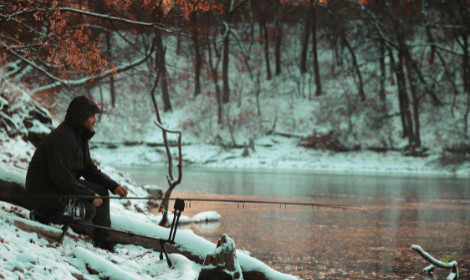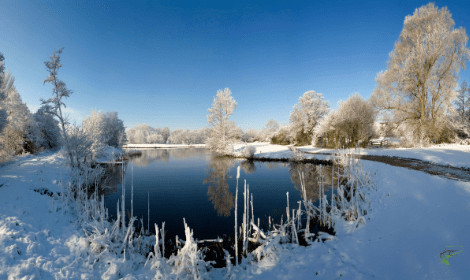
As air temperatures drop into winter, which slowly brings down the water temperature, carp enter a period of very low energy expenditure where they feed very little.
Natural food sources in the water are extremely reduced, and their body temperature drops in line with the water temperature.
This slows down their metabolism, and the fish can even sit motionless for periods if the water temperature drops significantly.
No matter what anyone says, the carp WILL still feed in the winter at some point, but they are not feeding as hard as during the warmer months, where they will actively be looking for food daily.
Sometimes, this feeding time might be reduced to only an hour a day in winter.
Working out when this feeding window could be and with a LOT of thought put into locating the fish, you still have a chance at putting fish in the net if you are willing to brave the cold.
The location you fish could single-handedly be the most important part of winter carp fishing as the carp will usually group up in areas that they feel most comfortable where water temperatures are high or more consistent.
It is not unlikely to find very large portions of the late empty of carp for winter.
Everyone should be asking, “where do carp go in winter?” if you want any chance of success throughout the winter.
This post will detail where you will usually find winter carp and some things you can look out for to locate them in the fishing venue.
Where do carp go in winter?
Unfortunately, the answer to this question will vary depending on the venue and also the weather conditions presented to you.
The wind, air pressure, water temperature, availability of food, and angling pressure are some things that can dictate where the carp are most likely to be.
We can, however, draw up some guidelines of where the carp are most likely to be that will provide a good starting point for any winter carp fishing approach.
Weather

The weather conditions play the biggest role in locating where the fish are.
As I said before, they will usually be shoaled up in areas where they feel the most comfortable and water temperatures are at their warmest and most consistent.
As the water cools due to the lower air temperature in winter, the cold water sinks, mixing with the lower layers. However, once it cools below 4 degrees, the water will rise again; this is why the bottom of lakes never freeze.
This means in periods of extremely cold weather, the carp can often be found in deeper water, but in the UK, water temperatures are rarely usually that low, or if they are, the chances are you won’t be fishing anyway.
The fish can often be found in deeper waters on really cold days after long periods of low temperatures. This doesn’t necessarily mean they will be on the bottom, and they can often be found mid-water. Zig rigs provide a great way for fishing up in the water on days like this.
In periods of bright and sunny weather during winter, the sun can occasionally warm the water very slightly, so you may find the fish in the upper layers of the water or shallower areas making the most of the very slight heat.
The wind will have a bigger effect on warming water slightly; in sunny spells with a bit of wind, the slightly warmer surface temperature will be mixed by the wind.
In periods like this, it can be beneficial to check the shallows for signs of any carp, such as murky water, feeding bubbles or even carp showing themselves above the surface.
If you notice periods of really cold weather changing into milder weather, this can be a great time to fish as the carp will usually be slightly more active as the water temperature rises with the air temperature
Features
Now that you’ve got an idea of how the weather, temperature and wind influence where carp will be in winter, I’ll cover what features carp can potentially be found near or hiding within.
Snags
Snags are generally areas of the venue with protection for carp that they feel safe hiding up against or within. They will also commonly feel safe to feed in these areas if you can find them there.
Overhanging branches, fallen trees in the water or anything else the carp can take shelter near under the water are classed as snags.
Shallows
The shallows and margins are commonly targeted by anglers during the winter months when the carp are actively on the feed in the warmer shallow regions where a lot of natural food sources can be found.
These, however, should not be discounted in the winter if the weather is favourable. As I mentioned, spells of warmer temperatures with a little wind can mean these shallow areas warm up just enough to encourage the lethargic carp into some feeding.
A benefit with the margins and shallow water is that you should be able to spot carp here or easily see signs of carp, such as clear bottoms where the rest of the water is covered in debris, feeding bubbles or the water may be murkier here as the carp sift through silt and dirt for food.
Weeds
Large patches weeds are known to hold carp in the warmer months as they oxygenate the water, provide a good hiding place from angling pressure and hold natural food sources.
As they die off into the winter, they can still hold winter carp. The dense weed can retain warmth and some natural food sources even with the colder water temperature.
Lilly Pads
Dying lilly ads provide the same benefits as dying weed patches. Slight warmth, cover from angling pressure and also some natural food means they should not be discounted.
Bays
Sometimes, it is not uncommon to find large percentages of a lakes carp population tucked into bays or hard-to-reach corners.
If these areas are covered by plenty of overhanging trees and cover, they are protected from cold winds from the north or east, so the water may be slightly warmer.
Also, areas like this are generally unfishable, so the fish will feel safe and comfortable with no rigs in sight.
Reeds
Fishing tight up to reeds can also be productive in the winter months, providing the same benefits as dying lily pads and weeds.
Bars and Drop Offs
Another area to check for carp is areas where the depth changes significantly. As conditions change, the carp will change depth along the bottom, so by placing your rig here; you may have the luck of passing carp moving from deeper to shallower water.
These drop-offs can be hard to pinpoint without a good understanding of the venue. You can either count down a lead to give yourself an idea of depth change or ask the fishery manager, who will be able to roughly point you in the right direction.
That’s All
If you are looking to get out on the water for a spot of carp fishing over the winter, you must put a lot of thought into where the carp will be base on the weather conditions and the venue you are fishing.
Without doing so, chances are you’ll go home without even a nibble.
On the other hand, if you manage to find the fish during a small window of feeding, the results can be drastically different.
I hope this post has given you a bit of an understanding and food for thought on where you should be looking for winter carp.
If you have any questions, leave a comment below, and I’ll get back to you ASAP.

